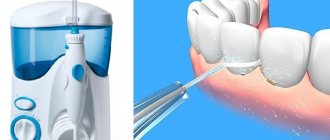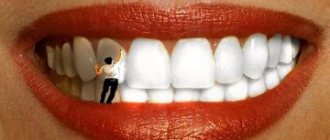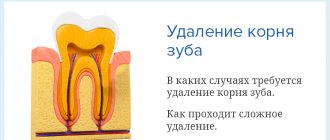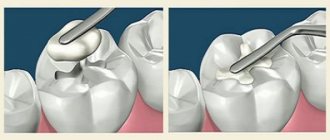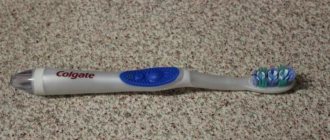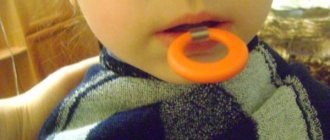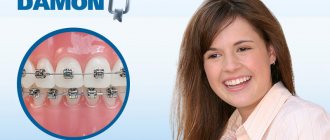What is a mouthguard for bruxism?
A mouthguard for bruxism is a special plate that is worn on one or two jaws at once. Its main function is to prevent the teeth from closing together, so that during a spasm they do not rub against each other. This allows you to preserve the integrity of the enamel and prevent exacerbation of the disease.
Important! A properly made mouthguard allows you not only to protect teeth from abrasion, but also to combat various orthodontic problems - malocclusion and other dental pathologies. In addition, if there are other dental structures in the mouth, the mouth guard will protect them from deformation.
Other tasks performed by a mouthguard include the following:
- the plate helps reduce muscle pain that occurs in the jaw area during spasm;
- it reduces the load on the jaw itself, thanks to which it is possible to avoid other diseases and deterioration of the patient’s condition;
- Thanks to proper use, you can return healthy sleep to a person even if he has frequent cramps at night.
It must be remembered that the mouth guard itself is not a complete treatment for bruxism. It acts only as an auxiliary tool that allows you to keep your teeth and jaw healthy during the period of symptoms. In order to get rid of the disease completely, the patient must undergo comprehensive treatment aimed at relaxation and relieving spasms.
Individual
Its production takes some time and consists of the following stages:
- Taking a copy of an impression - for this, a special viscous mass is used, which quickly hardens. It is applied to an impression tray and after making an impression of the jaw row, a dental copy appears on the cast. As soon as the impression gains strength, the model is ready for further use;
- Casting a gypsum frame - it is made from an aqueous solution and gypsum powder. The manipulation is no longer carried out by an orthodontist, but by a specialist in a prosthetic laboratory. A mass of thick consistency is mixed, which is carefully distributed over the initial print. When the composition becomes hard, the resulting frame of the jaw model is carefully removed from the molding material;
- Direct manufacturing of the structure - for this purpose, special high-quality medical components are used. Most often it is bioplastic or plastic biosilicone.
From such materials you can get the most convenient and functional devices. These substances can be either in the form of a mass or in the form of special plates, which is more convenient for the manufacturing process.
All work is carried out using a special apparatus - it sets the required pressure force (about 5 atmospheres), as well as an extremely high temperature - at least 140 degrees. Only under such conditions is it possible to produce a high-quality product that will be soft, comfortable and durable.
After all the manipulations performed, the model undergoes multi-stage lamination. This effect is called thermoforming. At this stage, all laboratory work is completed and the structure is transferred to the dentist for final fitting and possible adjustment.
The main condition for successful treatment of bruxism is the most accurate fit of the mouthguard combined with comfort for the patient, so all errors are corrected, and only after that the device is installed in the oral cavity.
At the same time, the inner part of the model is specially made softer in order to minimize pressure on the gums , avoid mechanical injury to them and not cause inconvenience to the user.
The outer zone, on the contrary, is harder and more durable, because not only all treatment functions are assigned to it, but also the loads associated with eating and chewing food.
Indications and contraindications
The main indication for use is the presence of symptoms of bruxism in a person. It does not matter how often and intensely they manifest themselves. The use of such structures is absolutely safe, so it cannot bring any negative consequences.
The age of the patient also does not matter. Mouthguards are very actively used in pediatric dentistry. This is due to their great efficiency and ease of use. However, in this case it is important to remember that children, due to their nature, may deliberately remove the plate. Therefore, to ensure quality treatment, it is necessary to conduct explanatory conversations with them and monitor the implementation of recommendations.
Other indications for use include:
- deformations of the dentition of various types;
- presence of malocclusion;
- the gaps between the teeth are too large or, conversely, too small.
All these problems can occur against the background of bruxism symptoms. In this case, the mouthguard will have a complex purpose.
As for contraindications, they practically do not exist. The structures are made from safe materials; they are securely attached to the teeth and do not cause discomfort. However, if the patient has certain mental disorders, he may be denied a mouth guard. Epilepsy is especially dangerous in this case. During an attack, the patient may accidentally swallow the plate, after which it will block his airway, thereby causing suffocation.
Advantages and disadvantages
The main advantage of these structures for bruxism is their ease of use. Such plates do not need to be attached to the teeth or installed using additional crowns. They can be used even in the absence of a certain number of teeth in the dentition.
At the right time, the patient can independently install the structure. It is very easy to care for her. It does not require the use of additional orthodontic instruments or medications. You can also remove it at any time necessary. You don't need to visit a doctor for this.
Another plus is the availability of a wide variety of multi-colored models for the youngest patients. Many of them are afraid of carrying a foreign body in their mouth. However, designs decorated with original drawings arouse children’s interest and the treatment process for bruxism becomes more enjoyable and easier.
The main disadvantages of using mouth guards include the discomfort they cause in the patient during the first period of wearing. Usually, it takes about a week for a person to get used to the design. But, given that in most cases these plates need to be worn only at night, this disadvantage becomes insignificant.
Types of mouth guards for bruxism
In modern dentistry, there are many types of mouth guards. They differ in the way they are used and the material from which they are made. In addition, their purpose may be different. It is very important that the dentist choose the most suitable option that could solve the problem more efficiently and quickly.
Day and night
Designs that are used for bruxism are divided into daytime and nighttime versions. They have differences in their appearance. Since the former need to be worn throughout the day, they usually have a neater shape and smaller sizes. Thanks to this, such plates do not interfere with talking or eating. They are made from transparent materials, which makes them almost invisible in the mouth.
As for the night ones, they are usually larger than the day ones. These structures exactly repeat the shape of the dentition, but you cannot eat or talk in them. These options are used when the patient’s symptoms of bruxism appear exclusively at night. Daytime ones are intended for more serious cases when spasms recur during the day.
Universal and customized
Universal models are made in medium sizes. They are usually used for mild forms of bruxism, as well as in cases where the person does not have associated bite problems. The advantage of such options is that they do not require additional production time. However, they also have disadvantages - they can cause slight discomfort while wearing, since they do not repeat the exact dimensions of the jaw and dentition.
Individual models are always made for each specific patient. At the initial stage, the specialist makes a cast of his jaw. Next, the design itself is manufactured according to the sketches. After fitting, the doctor can transfer the finished product to the patient for use.
Preventative, repositioning and resonating
The main purpose of preventive options is to protect the dentition. If a patient exhibits periodic symptoms of bruxism or is suspected of this disease, these are the models that are prescribed to him. Usually they are used only at night to prevent the wear of tooth enamel at a time when the person himself or his relatives cannot monitor the presence of spasms.
As for repositioning and resonating ones, these types are used for more serious cases of bruxism. In addition to the direct protective function, they also have a therapeutic purpose. Repositioning ones have an impact on the head of the jaw. When used systematically, they put pressure on this joint, changing its location. As a result, this reduces stress and prevents the onset of symptoms.
Resonating ones have a relaxing effect. Their main task is to reduce spasms by influencing the jaw muscles.
Thermoplastic
Thermoplastic is a special type of mouthguard made from a special material. It changes its properties when exposed to high temperatures. To install such structures in the mouth, they must be heated in boiling water in advance, then placed in the desired place and straightened. Thus, they take on the optimal shape, which follows all the curves and indentations in the dentition. When choosing such plates, the doctor is obliged to familiarize the patient in detail with the features of their use.
Night guards for straightening teeth
Being elastic, the product does not injure the gums. The trays are completely colorless and cannot be seen in the mouth. There are models that need to be worn not only at night, but also during the day. Such structures need to be removed only for eating and during hygiene procedures. Unlike braces, they are easy and quick to take off and put on. Aligners are made individually for each patient and are usually supplied in a set, which can contain from two to thirty pieces, depending on the course of treatment. The aligners need to be changed once every 1.5-3 months.
Kinds
Alignment aligners are very diverse. Depending on the manufacturing method, the product may be:
- Individual - they are made for a specific patient. A 3D model of the jaw is first made. Such products are effective and convenient.
- Thermoplastic - made from a special material that can soften in warm water. Heated products are placed on the dentition. The cooled mouthguard will take the required shape.
Depending on what material the product is made of, aligners can be silicone or plastic. Both options are very similar.
By wearing time:
- Those that need to be worn 24 hours a day. Dentists recommend wearing these aligners 22 hours a day and removing them only before brushing your teeth and eating.
- Sleep guards. Used to eliminate minor anomalies. They are also used when there is a need to consolidate the result after a course of wearing braces. Night guards are worn only at night. Silicone mouth guards for teeth at night are especially popular.
According to age category, there are:
- For adults. According to statistics, mouth guards are more often used for adult patients.
- Children's night guards for teeth. Children are reluctant to wear orthodontic appliances, so treatment can take quite a long time. Due to their specific characteristics, children's teeth can be straightened quite quickly if you follow the dentist's recommendations. Children's mouthguards are very comfortable and do not differ from models for adults. In terms of function, these are absolutely identical products.
How are mouth guards made for teeth grinding?
The manufacture of these structures is carried out in special laboratories. For this purpose, modern high-quality polymers are used. They are resistant to mechanical and chemical influences and also have a long service life. Such materials can have different colors - from transparent to any bright shades.
To custom make a structure for bruxism, a specialist must first make an impression of the patient’s jaw. This is necessary in order to see the exact location of the jaw, as well as to note all the irregularities of the dentition. Thanks to this, you can make a model that exactly matches the surface of the teeth and will not cause discomfort while wearing.
Production time
The time required to manufacture the structure depends on the material used, as well as on the structural features of the patient’s dentition. There are cases when, after fitting, the doctor identifies certain inconsistencies that also need to be eliminated.
Usually it is possible to make a high-quality structure for the treatment of bruxism in 1-1.5 weeks. If there are serious violations, the dentist may recommend urgent production.
Important! The period required to manufacture the structure should be taken into account when ordering a second copy. Since there can be no pauses in therapy, it is better to order it even before the first one becomes unusable.
Treatment with dental trays at night
The first thing to do is make an appointment with an orthodontist. The doctor will carefully examine the patient and, if necessary, send for additional diagnostic tests. The next stage is making an impression, according to which the mouthguard will be made in the future. It is very important to treat caries and gum disease before starting orthodontic treatment. Also, many dentists recommend that patients undergo an enamel remineralization procedure. Many patients are concerned about the duration of treatment. It all depends on the severity of the pathology. On average, treatment with mouth guards takes from eight months to several years. Even despite such long periods, patients do not experience any discomfort, since the aligners are very comfortable.
The period of adaptation to the device is a maximum of several hours. Patients do not experience discomfort or pain. Aligners for straightening teeth are characterized by thinness and invisibility. Made individually for each person. On the websites of dental clinics you can find out how much mouthguards cost. The use of aligners will not be effective in case of severe malocclusion pathologies and crooked teeth. In such cases, treatment with braces is prescribed.
Recommendations for care and storage
It is very easy to maintain the structure. To do this, you should adhere to the following recommendations:
- After use, it must be rinsed with running water to remove bacteria, food debris, etc. If it becomes very dirty, you can use your usual toothpaste and brush.
- After washing, the structure should be carefully wiped.
- Do not expose the plate to high temperatures. It should not be boiled or dried with a hairdryer. Also, do not leave the plate in the open sun.
Throughout the entire period of using the bruxism mouth guard, the patient should carefully monitor its condition. If any deformations occur in the design, this may indicate that it is not suitable, or that the person has begun to experience complications. In each of these cases, you must immediately consult your doctor.
It is better to use special containers for storage. They can be ordered during the purchase of the structure itself. They will keep the plate clean and prevent any damage.
